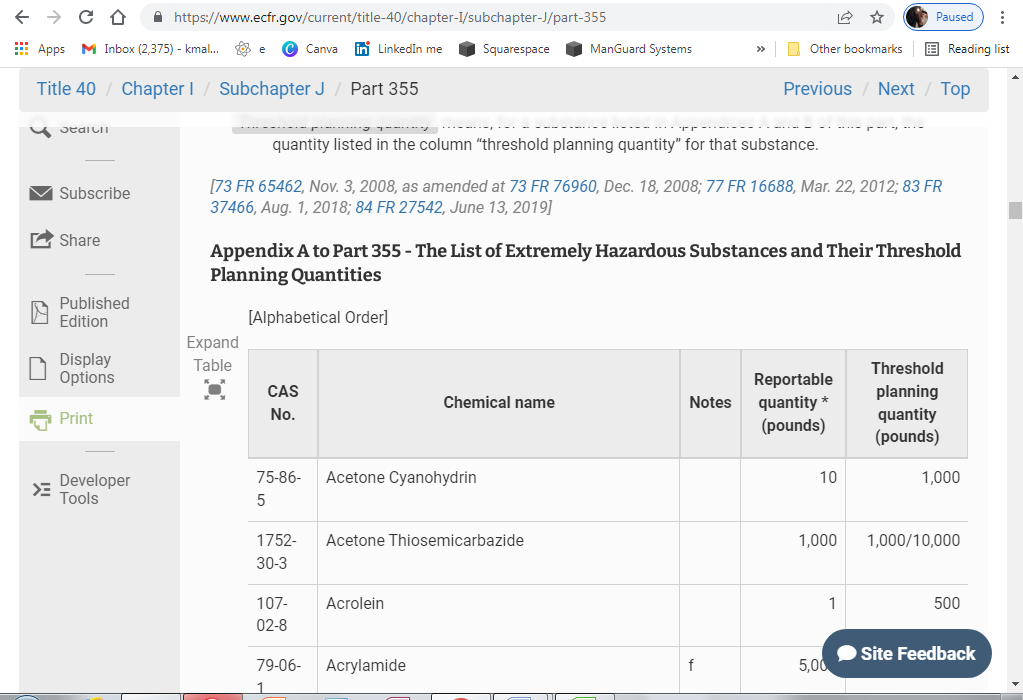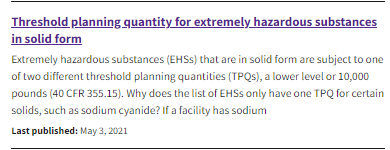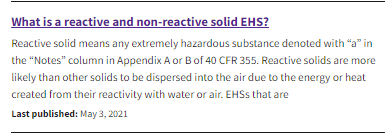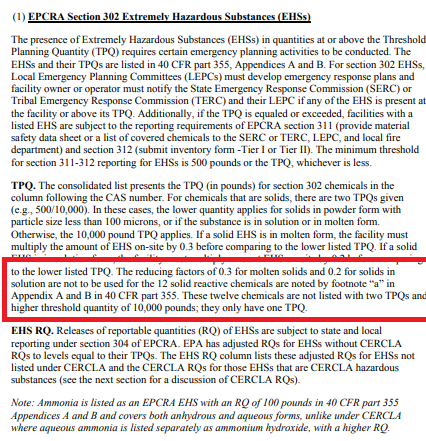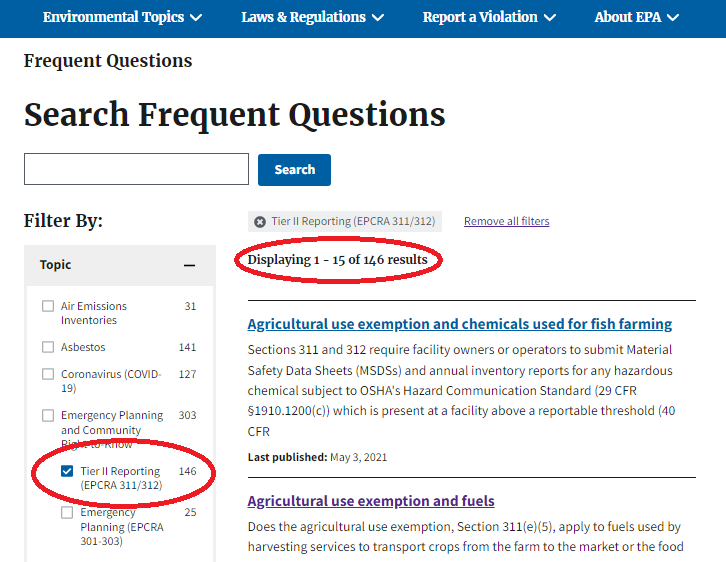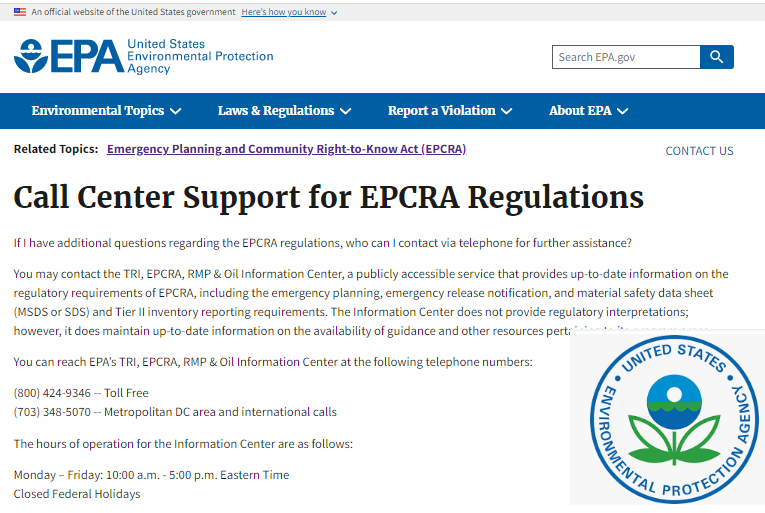17 Days: Solids not eligible for Non-reactive solid threshold contribution reduction
Happy Valentine’s Day! Let’s talk about reactive solids…
Twelve Reactive Solids: by definition not eligible for the non-reactive solid threshold contribution reductions
These chemicals are described in the regulations as “reactive solids”. They only have 1 Threshold Planning Quantity TPQ, not 2, and are NOT eligible for the reductions in amounts used to calculate threshold determinations available for non-reactive solids.
It was surprisingly difficult to find a list of the 12 reactive solids chemicals. I assembled it from the actual list in the regulations and it’s displayed below:
The Reactive solids include some chemicals recognizable (to me), for example:
Methyl Isocyanate, the gas released in Bhopal, India;
Potassium Cyanide, Potassium Silver Cyanide and Sodium Cyanide, I dealt with plating so was familiar with these, but probably most of us recognize the hazard associated with cyanides with respect to the potential to form poisonous Hydrogen Cyanide gas in the presence of acids
Lithium Hydride, I looked this one up,, component of some Lithium Ion batteries
. Phosphorus, I think most of us recognize the reactiveness of this
Sulfur Trioxide, which we saw in a previous example as a component of Fuming Sulfuric Acid
The others I would need to look up.
I got started down this rabbit hole based on the following FAQ:
I was familiar with the less than 100 micron provision for powders, in solution, and molten components to the Lower Threshold Planning Quantity TPQ provision.
But I was unaware of the National Fire Protection Association rating of 2, 3, or 4 for reactivity as an additional criterion for using the lower Threshold Planning Quantity TPQ value.
Check your Safety Data Sheet SDS if you think this might apply, and if the NFPA ratings are not provided on the SDS, you may need to do some additional digging to get the Reactivity value.
Another clarification of the differences between a Reactive Solid and a Non-Reactive Solid. This FAQ includes the following:
“EHSs that are reactive solids have only one TPQ assigned (no 10,000 lb TPQ) regardless of their physical state, form or particle size.”
The question of Reactive Solids compared to Non-Reactive Solids hadn’t even occurred to me, partially because the molten-solution threshold modifications came out after I had already been doing the report for several years.
Since there was only one Threshold Planning Quantity TPQ listed it never occurred to me to apply the non-reactive metal case. And for materials with two Threshold Planning Quantities TPQs, I always ran threshold determinations against the lower threshold, and never had a situation where it made sense to apply the reduction for non-reactive solids
Next I went to the pdf of the EPA List of Lists, where I found some text that seemed to be relevant to the FAQ above, (see below), but I was unable to find the “Note a” chemicals on the list. I was also unable to find the “a Notes” chemicals in the Excel of the EPA List of Lists.
Which is why I went back to the regulations, as shown above
The good news is that if you just treated Reactive Solids like any other Extremely Hazardous Substance EHS and calculated against their listed Threshold Planning Quantity TPQ, (of which there is only one) you would get the correct result.
I’m referencing FAQ’s around this topic, so I’m leaving the first 2 FAQ items of my FAQ posts in this post as well, how to get into the Tier2 FAQ and the EPCRA SARA Hotline number.
Remember that to Filter for Tier II Reporting only:
you will first need to check Emergency Planning and Community Right to Know on the main page,
which will give you the option to check Tier II Reporting (EPCRA 311/312),
after which you will want to uncheck Emergency Planning and Community Right to Know
so that you see 146 FAQs instead of 303 (the balance of the 303 are unrelated to 311/312)
Another non-intuitive and annoying (to me) feature of the way the FAQ’s work is that if you search, the web page unfilters before searching, so you no longer see only Tier2 FAQs. When you go back, you are still unfiltered.
Be sure to include the term Tier II in your search if you don’t want to expand the search to other (unrelated for now) topics.
I’ve provided both a link to the main (filtered) Tier2 only FAQs, and have included the hyperlinks at the bottom of each FAQ that I highlighted. So you can click those and still be looking at the appropriately filtered FAQs in a separate window if you want.
Below is one of the most useful, where to call for help. In my experience, while you may experience some “on hold” time, the information when you get to a person will be excellent and cross referenced to the particular citations or other resources clarifying the question.
EPCRA SARA Hotline
Whew! One rabbit hole that I didn’t know existed run to ground. Now tomorrow we can take on the rest of the non-reactive solids FAQs.
More tomorrow, here’s to March 2nd!
Community outreach: What other FAQs have you found useful (or just interesting)?
#SARA312 #SARATierII #SARATier2 #EPCRA #EGLE #March1EPAReportDeadline #ThresholdDeterminations #ExtremelyHazardousSubstances #EHS #ThresholdPlanningQuanitity #TPQ #EPAFAQ #CERCLAFAQ #SARAFAQ #EHSThresholdDeterminations #SARATier2FAQ #SARATier2ReactiveSolids #SARATier2NonReactiveSolids #EPAListOfListNoteA
Michigan Environment, Great Lakes, and Energy EGLE links from all three 2022 SARA 312 virtual training course webinars:
I’m reposting these links with my daily Tier2 post because they are so useful.
You can sign in and watch/listen even if you didn’t sign up for the webinar series.
RECORDING LINK FOR SESSION 2: Wed Jan 19, 2022.
Really good example on batteries. This is the “in the weeds” how to conduct your threshold determinations episode: https://attendee.gotowebinar.com/recording/4027906237723673347
I talked to Mike Young, one of the presenters, right after the first webinar. He said that it’s not unusual for them to take phone calls from people from other states (with the warning to confirm that your state doesn’t have differences in their requirements compared to Michigan).
RECORDING LINK FOR SESSION 1:
https://attendee.gotowebinar.com/recording/7957790593170499843
Michigan uses Tier2 Manager for report submission, which is a Michigan-specific program. If your state uses different software, you will need to review its specific requirements.
RECORDING LINK FOR SESSION 3:
https://attendee.gotowebinar.com/recording/2763075340284995085
If your state uses a different software program there may be some differences, but this webinar will probably also cover how to determine the Hazard Ratings, how to enter Locations, and other details associated with report submission. I’ll post the replay when it becomes available.
PRESENTATION: (I wasn’t able to attach a copy of the presentation, email the link below and they will send it to you)
SARA TITLE III – TIER II REPORTING WEBSITE: http://www.michigan.gov/sara
MICHIGAN FACILITIES’ GUIDE TO SARA TITLE III: https://www.michigan.gov/documents/deq/deq-oea-saraguidebook_509720_7.pdf
CONTACT INFORMATION:
Mike Young and Adam Pohl
517-284-7272


